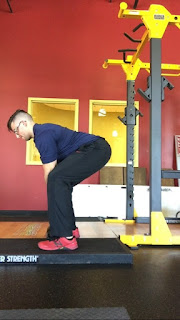I can’t think of better piece of
equipment in the gym than a kettlebell. There are over a dozen exercises that
can be done with a kettlebell but today I want to highlight one of my all-time
favorite exercises; The Kettlebell Swing.
The kettlebell swing (if done correctly)
can be an amazing exercise to incorporate into your program. Whether you are
looking to develop lower body explosive power, or just looking to tone up those
glutes for the summer, the kettlebell swing is sure not to disappoint.
It’s a Hinge NOT a Squat!
First and foremost, the kettlebell swing
is a hinge movement pattern, not a squat. A hinge is essentially maximal hip
bend with minimal knee bend (think deadlift). As the hips come back in your
hinge, the torso will begin to come down as well. On the other hand, a squat is
maximal hip and knee bend simultaneously. During a squat, the torso will remain
mostly vertical. This is a common error that I see most often with the
exercise.
Set Up and Execution
The set up for a kettlebell swing is
fairly simple. Begin with kettlebell on the ground in front of you. It should
be about arm’s length away. To begin, hip hinge back and place your hand firmly
wrapped around the handle of the kettlebell. At this point, you can shift your
weight back a bit and the bell should tilt on its side slightly.
While maintaining your hinged position,
you will ‘hike’ the kettlebell back towards your glutes.
1 2
Once the kettlebell has been hiked,
proceed by driving the bell forward using your hips, glutes and hamstrings. As the bell reaches shoulder height, engage
your lats, pecs, shoulders and core to decelerate the bell.
3
Tips
- Sometimes the arms will start to do all the work in the movement if the weight is too light. If you feel like you are not engaging your posterior chain during the movement, try using a heavier kettlebell. I find this sometimes will clear up that problem.
- Breathe! Breathing during the swing is very important. You should be exhaling forcefully as you drive the weight forward and inhaling at the top of the movement just as the bell begins to make its downward phase. Proper breathing during the swing will help brace the core and prevent injury.
- Be Patient! A lot of times I notice there to be a disconnect between the upper and lower body during the swing. The most common error I see is, during the downward phase, the client will break their hips back into a hinge before the kettlebell has reached the hips. Breaking the hips back early can cause the kettlebell to travel below the knee and in turn create excessive tension in the lower back.
Blog post by Greg Wilson.










